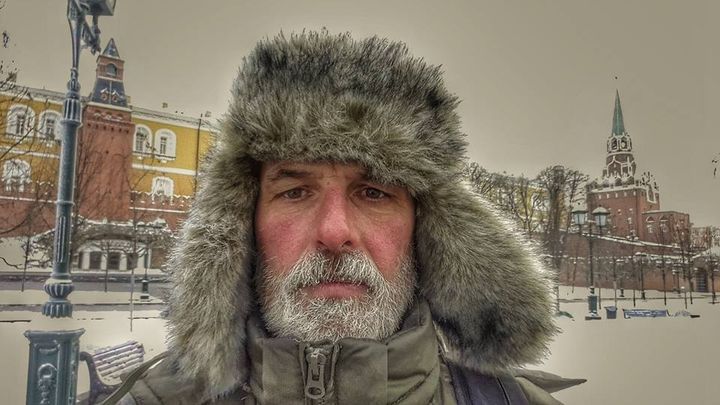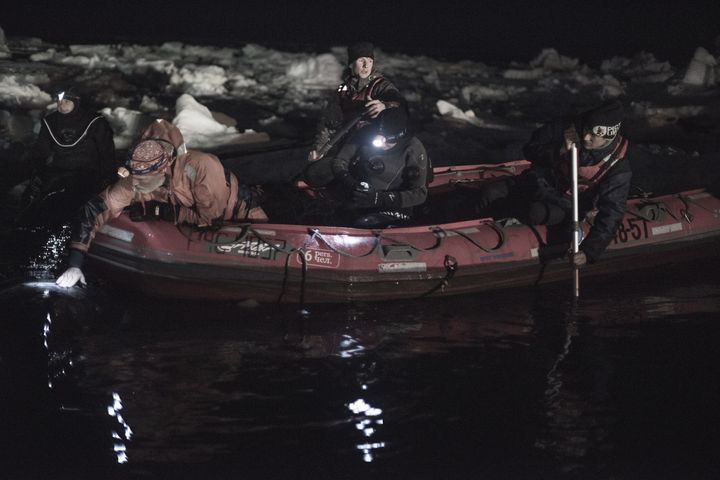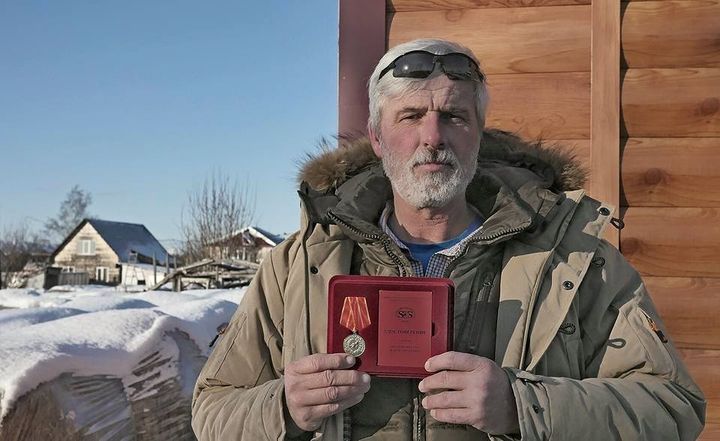
In April last year, four killer whales were found trapped among ice floes in the frigid water off the coast of Russia – the baby was separated from its mother and at risk of drowning while a young young male, wedged in shallow water, cried relentlessly to his family.
It must have been a daunting task, yet rescuers eased themselves into the water and went to work. Worldwide, people do what they can to help stranded whales and dolphins – but this story reflects both the courage and preparedness needed to help these large and stressed whales in dangerously inhospitable conditions. In December they were each awarded well-earned medals for their efforts.

Here is their story, as recorded and shared by rescuer Peter van der Wolf:
“During the night from 18-19 April, the wind had changed and blew sea ice straight towards the shore. A vast pack of an about 5 km wide ice field had piled up at the shoreline of the village Starodubskoye (which means “Old Oak village).
A pod of at least 4 orcas got trapped near shore in very shallow water, surrounded by a dense amount of ice floes. Orcas usually appear this time of the year at the edge of sea ice, hunting for seals.
The EMERCOM rescue officers were alarmed and arrived on scene during the morning of April 19.
Officers had been in the water from 12.30 (almost right after their arrival) til 6.30 PM in dry suits, trying to keep the ice away from the orcas and even preventing the baby from drowning.
The young whale almost got crushed between ice floes and one officers manged to keep the ice away, using his legs and a long wooden pole and thus creating a window for the baby to join with his mum in more open water.
Later that night we all at some point got sandwiched between these ice floes which apparently just seem to float, but due to their mass are so inert and difficult to stop when they are coming your direction. Especially in shallow water, ankles and knees got often stuck and almost squashed by the hardened, sharp edges of the ice. I think that is what we all felt as the most scary and dangerous part.

They spent the whole day keeping the ice as far away as they could from the orcas and in the afternoon of April 19 at around 15.30 hrs, a mother with calf and another young whale managed to find a way out through the shifting ice floes.
The [young] male of about 10 years old remained the closest to the shore in a pool of shallow water, partly blocked by rocks and ice floes. Two divers from Dive Club Sakhalin volunteered and were keeping the whale wet, avoiding dehydration of the vulnerable skin.
I was called by local people to come over and help at about 16.00 hrs and I contacted my friends at Klub Bumerang, a very active environmental orientated – Yuzhno-Sakhalinsk based NGO, to find out what we could do.

When we all arrived on scene at 19.00 hrs we assessed the situation while we still had a few hours of daylight and we tried to spot for an escape route. At 21.40 hrs it became low water and high water was expected at 4.00 hrs the next morning, so we knew we had a small window. The EMERCOM officers were tired and needed rest after being out on the ice the whole day.
Klub Bumerang sent a truck with additional volunteers, equipment and dry suits to the village Starodubskoye. I was in contact with Russian marine mammal expert Olga Sphak in Moscow, and discussed treatment and medication.
When Klub Bumerang arrived, quickly a big tent with a propane heat canon was deployed and volunteers started making soup and tea.
At the same time we received medication from Yuzhno and together with para medic Ekaterina I prepared a mild dose of dexametazone, a drug that (amongst others) stabilises breathing and heart rate. The male orca had been trapped already for more than 12 hours and his frequent crying sounded like distress calls. We knew we had to keep him out there that night, because another days in shallow water might be fatal.

We all dressed in dry-suits and waded about 100 meter through the chest deep water (-1 Celsius) [30 F] to the orca. It was already dark by then. Andrey, one of the volunteers (electrician by profession) had installed a huge flood light that gave us enough light to work in.
Ekaterina and I prepared the injection, we had to use a huge syringe to penetrate the very strong and thick skin. We managed. We covered the orca with sleeping bags because when orcas don’t swim they may get hypothermia. Ekatherina and I carefully applied Vaseline around the blowhole to avoid hydration of the sensitive skin.

Everyone was very cold after being in the water for about 2 hours and we quickly returned to the shore were we had warm tea and soup. We had a short break for about half an hour and after midnight we returned back the orca, which was already nicknamed “Willy”. Checking water depth and underwater obstacles like rocks, we found a more or less suitable way, hoping for the high water tide to help. Willy had to leave the small pool where he had been lying in for so many hours and we started to remove the ice floes. 6 rescuers turned very gently and careful the 7 meter long, 6,5 ton whale and maneuvering him out of his pool.
I went ahead in a small raft to check water depth and show where we had to move Willy.
Working in such cold water, surrounded by ice floes is not without risk. As the tide rose, the waves picked up and we had to be very careful with ice floes propelled by waves, crushing in on us, the boats and the whale. And one uncoordinated move of the almost 7 ton orca could squeeze a rescue worker like a fly.
The orca seemed to understand what was going on. Rescuers where constant near him, grasping his pectoral flippers and tail, pushing his body slowly forward. Willy did a very clever thing and it took us a while to understand why he did it: when the water became too shallow, he turned on his side. We were thinking : “Oh, now he dies….” but because of his elongated flippers protruding 50 cm under his body, the flippers were actually hindering him in shallow water. They would make him higher in the water, so when he turned on his side, he was able to retract one flipper under his body, reducing his “height” and thus becoming smaller. Lying on his side, he wriggled his body over stones, and at times exhaling his breath and trimming his buoyancy, his body became even less wide. We were waiting for a small waves, so we could push him this way very slowly to deeper water.

It took us about 3 hours to move him 130 meters, and we were very lucky that the tide was rising. I was in the water, steering his huge tail fin whilst the Bumerang and EMERCOM rescuers were pushing his pectoral fins. We literally steered him around all obstacles until the water became too deep for us.
Now it was up to Willy. We at one instance noted that his enormous dorsal fin, which had been collapsed for many, many hours (usually a sign of distress, sickness or depression in orcas) suddenly stood up had grown back to its full majestic length. The orca started to beat his big tail on the water and shaking his head up and down, pushing him self forward through the last part of shallow water. He seemed to gather his strength for a moment and with a loud squeal and blow, he really took off like a torpedo, into the dark night and heading for open sea.
The emotion we all felt was sheer happiness, tears, cries, joy…..no words to describe.
Willy got free near 5.30 hrs. on April 20. One of the most beautiful dawns we all ever witnessed….. a pink-greenish light at the horizon told us, another day for the orca and his pod.
Another surprise waited us.The wind had shifted again during the night and the pack ice that had closed the shoreline was broken and huge pieces of open water were visible. We all knew that Willy was looking for his pod or perhaps already had joined it
The EMERCOM rescue workers and Klub Bumerang started packing their gear and all left at day break. So amazing how a small group of people became so close to each other, when working together in this kind of circumstances.”

Peter van der Wolf is among the rescuers who received medals from the Federal МЧС for their involvement during the rescue of orcas that stranded in Staradubsk, Russia.
